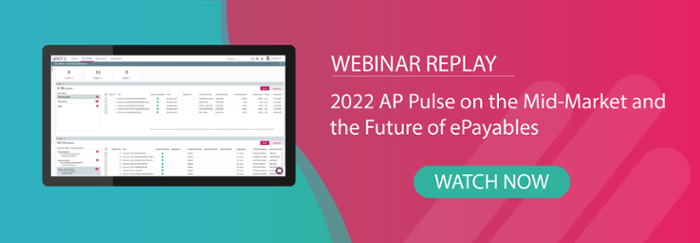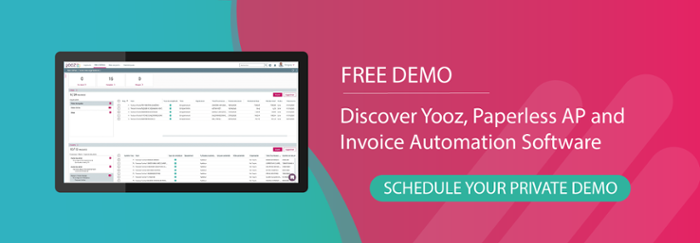Every crisis is a chance for a fresh start, enabling organizations to take stock of what’s working and what should be changed. As painful as the 2019 pandemic was and continues to be, it has made companies of every size and in every industry aware of the importance - and necessity - of an efficient back-office function. This awareness translated into a more rapid embrace of and to digital transformation, especially in the adoption of an automated purchase to payment system.
In fact, the accounts payable (AP) profession implemented electronic invoicing in record numbers in 2020, demonstrating an amazing level of creativity, efficiency, and resilience towards processing, approving, and paying invoices on time. The good news? By doing so, the AP function is operating at the height of its game.
However, record numbers aside, change is just beginning to pick up speed. Nearly 200 respondents across 20 different industries told Ardent. “The industry has reached its highest technology adoption rates yet, while also seeing an increase in those that plan to deploy solutions in the near-term,” the report says. “A majority of accounts payable teams will be operating with new tools at hand. Many more will be operating with a new mindset.”
Alongside the ongoing change in office versus remote work structure, the addition of new tools, and a new strategic approach, 2021 is set to see accounts payable workers getting the recognition that they deserve. Ardent Partner says in its latest report “The State of ePayables 2021: Operating in the New Normal” that AP leaders are well on track to “…become an operational engine that quickly processes transactional activity while focusing its resources on providing deep financial intelligence that can be leveraged for critical enterprise decision-making.”
What Is An E-Invoice?
The traditional invoice processing method is a series of manually intensive, paper-heavy tasks including individually entering invoice data, sorting formats, creating paper invoices, manual checks/balances, and endless amounts of filing. Someone had to physically receive documents, enter or save the information, route them as appropriate, hopefully catch any fraud or errors, and maintain whatever physical container space was required. The sheer volume resulted in human error, increased costs, and long processing lifecycles for companies.
Electronic invoicing (e-invoicing) changed all this, taking the same processes and conducting them over an electronic interchange. No more waiting for the mail or fax machine, e-invoicing software lets you both receive and submit payments. Particularly in today’s environment, this type of electronic data interchange (EDI) eliminates the backlogged caused by a remote work environment.
Does Electronic Invoicing Sound Productive?
Simply in terms of speed and resulting productivity, the benefits of electronic invoicing are obvious. In fact, end-to-end AP automation has many tangible benefits that have a direct impact on the bottom line. These include the following seven key technologies:
- Document imaging and scanning
- Automated routing and approval workflow
- Electronic invoicing
- Automated data capture and extraction
- Electronic B2B payments
- Complete procure-to-pay solution
- Self-service supplier portal
Companies that can master these technologies to handle invoices will reap the biggest efficiency and productivity gains, saving space, time, and money.
Six Ways Electronic Invoicing Benefits Every Business
Companies that innovate along their entire invoice workflow can almost immediately unlock all that digital transformation has to offer. This is the “holy grail” of electronic invoicing: straight-through processing from purchase to payment with no human intervention required. A cloud-based platform such as Yooz enables the electronic invoice to flow freely through the entire AP process as they are absorbed, coded, routed, approved, and paid in record time. Besides the improvement and benefits in process use, automation benefits customer service as well. This holistic approach has been winning over an increasing number of companies, as Ardent points out: “For a majority of leaders overseeing AP, the pandemic made it patently obvious that manual processes are no longer acceptable and must be stricken from the workplace.”
- Slashing processing cost and cycle times. While the average total cost to handle a single invoice stood at 95 cents in 2020, best-in-class players only paid 25 cents per invoice. Likewise, they were able to cut processing time from 11.9 to 3.3 days, realizing discounts for both early payment and optimizing cash management for the entire company.
- Getting a handle on costly exceptions. Typically, 1 in 4 invoices is flagged as an exception and needs human review, while best-in-class organizations report only 1 in 10 exceptions. This is due to features such as the capability to automatically perform two- or three-way matching for every invoice to weed out duplicates or outright fraud. “The amount of staff time dealing with invoice exceptions is costly, but it also delays payments, disrupts cash flow, and keeps the AP team from focusing on higher-leverage/more strategic activities,” according to Ardent.
- Enabling suppliers to become part of your business network. Setting up your vendors and other partners to send and receive electronic communications, most importantly invoices (in pdf or other formats), is a game-changer. Yet while almost two-thirds of AP automation leaders have onboarded their partners, only slightly more than a third of all other companies support this function. It´s a “critical gap that most organizations still need to address,” the report warns.
- Mastering electronic payments as a win-win. B2B payments offer financial and other benefits to both sides of a transaction. While most companies surveyed (51%) support B2B payments, there is still room for improvement. Companies that actively try to optimize how they pay their suppliers via digital and electronic means will not only boost their visibility into cash and spend and reduce payment fraud. They’ll also get more support from key vendors if invoices are processed and paid through their desired channels. A platform such as Yooz lets companies initiate seamless electronic payments through its partners through transfers or electronic checks.
- Turning the AP function into an intelligence hub. Having various pieces of technology up and running covers only one core competency of electronic invoicing. Putting it all together unlocks the next level of successful AP automation. It makes the AP function with its rich real-time data gleaned from invoices a hub of financial intelligence.
“The most intelligent teams rely upon a few common elements: collaboration, communication, best practices, automation, data, data management hubs, algorithms, and analytics,” according to Ardent Partners. “AP sits on a goldmine of data… the downstream flow of invoices and payments is an incredible channel for transactional data that can paint a vivid picture of what is happening across the organization.” - Earning the recognition the AP personnel deserves. As dispersed finance departments kept their businesses going, working remotely in challenging times, companies discovered the inherent value of electronic invoicing. As Ardent reports, two-thirds of enterprises now recognize their AP team as either very valuable or exceptionally valuable.
“The pathway for AP in 2021 and beyond is clear,” the report summarizes: “Become a self-sustaining engine of intelligence and operational prowess, ready to support strategic enterprise endeavors while serving as a source of financial knowledge that can impact heavy, mission-critical corporate decision-making.”
The Gig is Up! Any Business Can Handle It
There’s another urgent reason why it makes sense to embrace a solution like Yooz to read and route invoices in record time so they can be approved, paid, and analyzed for maximum productivity. It’s a massive disruptor called the gig economy, a free-market system based on temporary positions and independent, short-term workers. Why is this increasingly important? Almost half the workforce of all companies Ardent surveyed in 2020 was classified as “contingent” or “non-employee” and working on-demand.
As more enterprises rely on an agile workforce to quickly find the skills they need, electronic invoicing is a key component to better manage and pay those gig workers. The pandemic taught companies that they need to improve their workforce flexibility and scalability. Ardent sees a golden opportunity to get even more out of end-to-end automation powered by Yooz: “AP can play a pivotal role in not only ensuring that payment data is leveraged in workforce planning, but that key gig workers and contractors are paid quickly and efficiently for the sake of the talent experience.”
Don't miss out on the benefits of electronic invoicing; act today!

.jpg)





